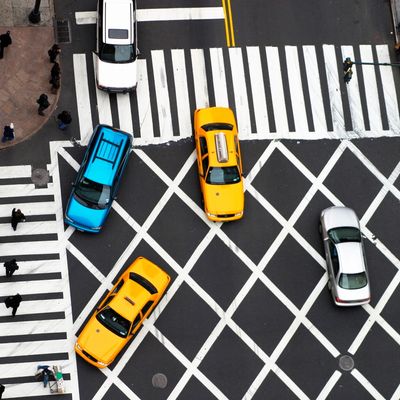
Stepping off a curb in Manhattan can be a frightening experience: buzzing cabs, fast buses, hoards of tourists. But the Department of Transportation and New York City are investing in technology that might make it a slightly less terrifying one.
Today, Secretary of Transportation Anthony Foxx announced a new pilot program that will give up to $42 million to the city, along with Tampa and the state of Wyoming, to invest in technology that lets vehicles talk to one another and to their surroundings in order to reduce congestion, prevent accidents, and cut emissions. The hope is that such technology might help slash the unimpaired vehicle crash rate by as much as 80 percent.
The “vehicle to vehicle” and “vehicle to infrastructure” technology in question could be a dramatic step forward for safety on the roads. So-called “connected vehicles” talk to one another, as well as to signs, lights, and data-collection points, often over dedicated wireless channels via special hardware.
That means that a truck, for instance, could convey its direction and speed to the road, helping cities with things like stoplight timing to alleviate congestion. It could also convey its direction and speed to a pedestrian or bicyclist with a smartphone app, warning him of the potential collision. And drivers could get alerts when they exceeded the speed limit, or warnings about avoiding traffic jams.
Signing up for the pilot might help aid in Mayor Bill de Blasio’s plan to eliminate traffic deaths in the city. Last year there were 248 traffic fatalities in New York, including 132 pedestrians, 20 bicyclists, 37 motorcyclists, and 59 people in motor vehicles. De Blasio’s administration is treating all such deaths as preventable, pushing initiatives to lower speed limits and increase enforcement.
The new technology might also help improve safety. “You’ll probably experience fewer fender benders,” Foxx told me, describing what the technology’s real-world effects might be in midtown. “You’d probably have fewer collisions with pedestrians. You’d also notice more coordinated signalization,” he said, helping to “ease traffic flows in a very congested part of America.”
New York City will use the money to install “vehicle to vehicle” tech in 10,000 cars, buses, taxis, and limousines that often travel in midtown. It chose particularly dangerous and congested parts of the road for “vehicle to infrastructure” technology, using traffic and fatality data from 2009 to 2014. It expects that all of the traffic signals on First, Second, Fifth, and Sixth avenues between 14th and 66th streets will get an upgrade, as will traffic signals on Flatbush Avenue between Grand Army Plaza and Tillary Street in Brooklyn. There will also be roadside units installed on FDR Drive between 50th and 90th streets.
Foxx said that the government and private firms have spent more than a billion dollars developing this kind of technology, and that an early connected-vehicle pilot in Michigan had shown great promise in making the roads safer. “We’re trying to draw in local communities and private businesses that could benefit,” he said, “and to engage them in early adoption.” The department plans to issue rules requiring “vehicle to vehicle” tech in cars soon.
Such connected-vehicles programs also might help cities get more bang for their buck from their existing infrastructure, saving money in the long run, he said. “We’re going to have 70 million more people in this country over the next 30 years,” he said, “so getting as much capacity of the road network is the goal. And the safety benefits aren’t to be understated.”
Many a New York pedestrian has her fingers crossed that he is right.





























